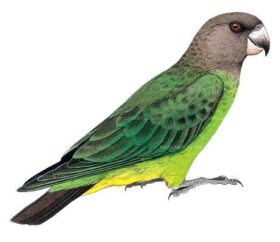Content |
|---|
Description:
25 cm.. length.
The Niam-Niam Parrot (Poicephalus crassus) has the head and nape Brown olive; the ear-coverts Silver. feathers of the the mantle and tertiary Brown with dark green margin; back, uppertail-coverts and bright green.
Upper, wing-coverts dark green; secondary more internal dark green; rest of the flight feather brown with vane dark green external. Throat and top of the chest Brown olive opaque; bottom of the chest, the belly, the the thighs and undertail- coverts green.
Feathers of the tail dark brown tipped with dark green margins.
Bill yellowish, upper jaw darker than black-tipped; irises yellow; legs blackish.
Both sexes similar.
Hood grayish brown of the immature It shows strong brands of color yellow olive; the the mantle is greener. Underparts paler and more yellowish in adults. Secondary internal lined with yellow. More pale the upper jaw the adults and with grey tip.
It was thought that the Niam-Niam Parrot (Poicephalus crassus) could form a species within the group of the Poicephalus meyeri, Poicephalus rueppellii and Poicephalus cryptoxanthus, and possibly other. In the past, treated as species Poicephalus cryptoxanthus, that is morphologically very close.
Habitat:
Frequents wooded areas of Savannah, forest-savanna mosaic, wet sheets and Syzygium-Adina forests in the savanna to the 1.000 m.
Common in areas near water. Observed in pairs or in small groups. Regular daily movements take place even in the mountainous areas where the Niam-Niam Parrot visit tall trees to feed.
Reproduction:
Few details about reproductive biology, but believes that nest between August-September during the rainy season.
Courtship and implementation not described.
Food:
Its diet It is little known but includes a wide variety of seeds; reported foods include millet, and beans.
Distribution:
Size of the area of distribution (reproduction / resident): 343.000 km2
North of Central Africa to the South of the Sahara. Believed to inhabit also in Cameroon Eastern (where is the status unclear) through the Center and South of the Central African Republic, South-West end of Chad and the north end of the upper area of the Democratic Republic of the Congoto the southwest of Sudan (Bahr-el-Ghazal).
Sedentary with local movements. Little-known state, but think it's generally common, Although most scarce in the southwest of Sudan.
Conservation:
• Current Red List of UICN: Least concern
• Population trend: Stable
The size of the world's population has not been quantified. This species is one of the lesser known African parrots, but it is assumed that it is common in its area of distribution.
The population is suspected to be stable in the absence of evidence of any reduction or substantial threats.
"Niam-Niam Parrot" in captivity:
Very rare in captivity.
It is a parrot of middle voice, shy and suspicious. Young birds are more accustomed to the caregiver.
New birds susceptible to the stress or illness.
Is necessary for their well-being a regular supply of fresh wood; susceptible during the acclimatization period; resistant once acclimated.
Alternative names:
– Niam-Niam Parrot, Niam niam Parrot (English).
– Perroquet des Niam-niams, Perroquet des niam-niam (French).
– Niamniampapagei, Niamniam Papagei (German).
– Papagaio Crassus (Portuguese).
– Lorito Niam niam, Lorito Niam-niam, Lorito nianiam (español).
scientific classification:

– Order: Psittaciformes
– Family: Psittacidae
– Genus: Poicephalus
– Scientific name: Poicephalus crassus
– Citation: (Sharpe, 1884)
– Protonimo: Pionias fat
————————————————————————————————
“Niam-Niam Parrot” (Poicephalus crassus)
Sources:
– Avibase
– Parrots of the World – Forshaw Joseph M
– Parrots A Guide to the Parrots of the World – Tony Juniper & Mike Parr
– Birdlife
– Photos:
(1) – Photography: Caijin Wen – link


